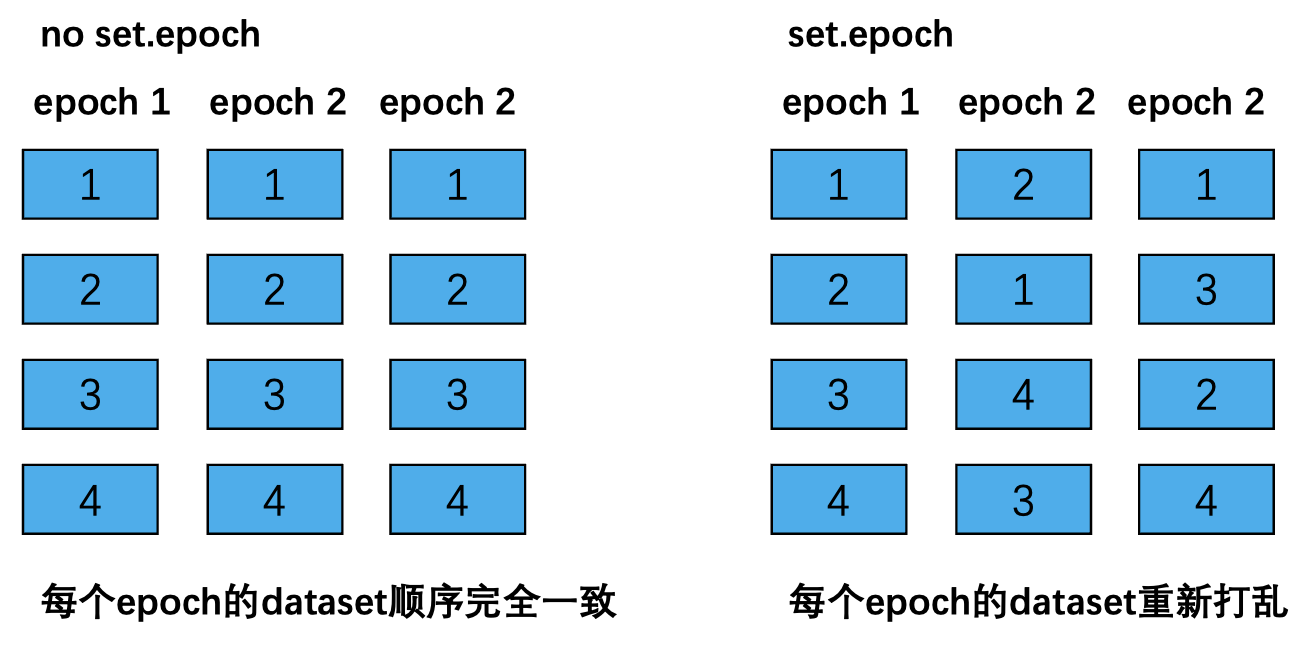DistributedSampler和BatchSampler的关键参数
| DistributedSampler | BatchSampler |
|---|---|
| dataset // shuffle // drop_last | sampler // batch_size // drop_last |
1. DistributedSampler
torch.utils.data.distributed.DistributedSampler(dataset, num_replicas=None, rank=None, shuffle=True, seed=0, drop_last=False)
- dataset: Dataset used for sampling
- num_relicas: 参与分配的进程数,默认自己检索
- rank: 进程编号,默认自己检索
- shuffle:default=True
- seed:如果shuffle=True,对于分布式中所有处理相同,default seed=0
- drop_last:当数据除GPU无法取整的时候,是否将多余数据舍去,不舍去的话需要从头取数据补全,default=False,即不舍弃
设置dataset的子集用于分布式训练
Sampler that restricts data loading to a subset of the dataset.
注意在分布式的模式中,在每个epoch要调用set.epoch函数,不然进行迭代时每次都是相同的数据集顺序
这个函数看着介绍比较难懂,下面通过例子来解释:
不调用set.epoch
运行:CUDA_VISIBLE_DEVICES=0,1 python -m torch.distributed.launch --nproc_per_node=2 --master_port 29501 exe.py
import torch
import torch.nn as nn
from torch.utils.data import Dataset, DataLoader
from torch.utils.data.distributed import DistributedSampler
import random
import numpy as np
seed = 1234
random.seed(seed) # seed for module random
np.random.seed(seed) # seed for numpy
torch.manual_seed(seed) # seed for PyTorch CPU
torch.cuda.manual_seed(seed) # seed for current PyTorch GPU
torch.cuda.manual_seed_all(seed) # seed for all PyTorch GPUs
output_size = 2
batch_size = 2
data_size = 16
torch.distributed.init_process_group(backend="nccl")
local_rank = torch.distributed.get_rank()
torch.cuda.set_device(local_rank)
device = torch.device("cuda", local_rank)
class CustomDataset(Dataset):
def __init__(self, length, local_rank):
self.len = length
self.data = torch.tensor([1,2,3,4,
5,6,7,8,
9,10,11,12,
13,14,15,16]).to('cuda')
self.local_rank = local_rank
def __getitem__(self, index):
return self.data[index]
def __len__(self):
return self.len
dataset = CustomDataset(data_size, local_rank)
sampler = DistributedSampler(dataset)
data_loader = DataLoader(dataset=dataset,
batch_size=batch_size,
sampler=sampler)
for epoch in range(2):
# sampler.set_epoch(epoch)
for data in data_loader:
if local_rank==0:
print(data)
'''
*****************************************
Setting OMP_NUM_THREADS environment variable for each process to be 1 in default, to avoid your system being overloaded, please further tune the variable for optimal performance in your application as needed.
*****************************************
tensor([13, 10], device='cuda:0')
tensor([12, 14], device='cuda:0')
tensor([ 3, 16], device='cuda:0')
tensor([5, 8], device='cuda:0')
tensor([13, 10], device='cuda:0')
tensor([12, 14], device='cuda:0')
tensor([ 3, 16], device='cuda:0')
tensor([5, 8], device='cuda:0')
'''
调用set.epoch,即将上述代码中的sampler.set_epoch(epoch)注释取消掉
'''
*****************************************
Setting OMP_NUM_THREADS environment variable for each process to be 1 in default, to avoid your system being overloaded, please further tune the variable for optimal performance in your application as needed.
*****************************************
tensor([13, 10], device='cuda:0')
tensor([12, 14], device='cuda:0')
tensor([ 3, 16], device='cuda:0')
tensor([5, 8], device='cuda:0')
tensor([6, 7], device='cuda:0')
tensor([12, 8], device='cuda:0')
tensor([ 2, 10], device='cuda:0')
tensor([11, 14], device='cuda:0')
'''
对于上述输出,当不使用set.epoch时,两个epoch的cuda:0中的数据顺序是一致的,而使用set.epoch时,两个epoch的cuda:0中的数据不同,也就是说,set.epoch在每个epoch设置了不同的随机种子
我这里采用了两张卡,最终数据是平均分配的,也就是说数据被随机的分成了两份进行分配
还有一点需要注意的:如果我们在训练过程中加入了torch.utils.data.BatchSampler,原理依旧是不变的

2. BatchSampler
torch.utils.data.BatchSampler(sampler, batch_size, drop_last)
- sampler: 一个可以迭代对象
- batch_size: mini-batch的大小
- drop_last: True的话凑不够batch_size的那部分会被舍弃
产生一个mini-batch的索引
from torch.utils.data import BatchSampler
sampler = list(BatchSampler(range(10), batch_size=3, drop_last=True))
sampler2 = list(BatchSampler(range(10), batch_size=3, drop_last=False))
print(sampler)
print(sampler2)
'''
[[0, 1, 2], [3, 4, 5], [6, 7, 8]]
[[0, 1, 2], [3, 4, 5], [6, 7, 8], [9]]
'''
一般来说在分布式训练的时候,先执行DistributedSampler,然后执行BatchSampler,将BatchSampler传入到DataLoader即可






















 2967
2967











 被折叠的 条评论
为什么被折叠?
被折叠的 条评论
为什么被折叠?








